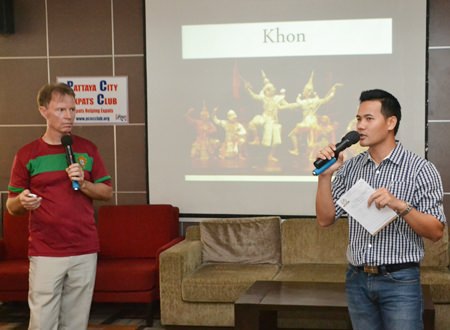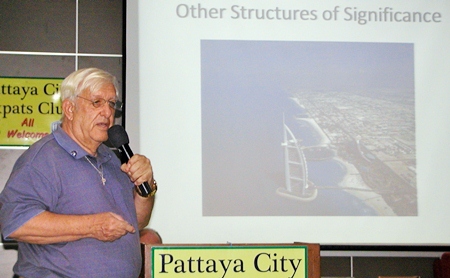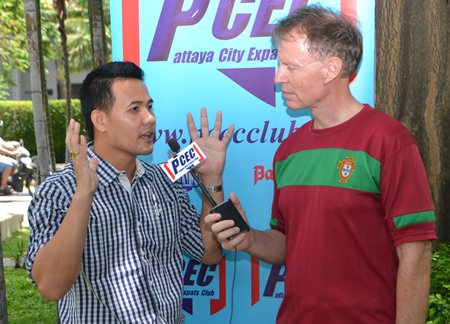The practice in Thailand of not using your finger to point at someone may have had its origins in the Ramakien, Thailand’s national epic, derived from the Hindu epic Ramayana.
Ren Lexander and Prasit Foobunma spoke to the club last Sunday on the topic “Ramakien and Thai Culture.” The Ramakien is an epic story involving demons, gods, princesses, reincarnation, lust, wars, and monkey kings. The Ramakien has had a persuasive influence across Asia where the Hindu myth was adapted to Buddhism, Jainism and Islam. Ren said that the Ramakien has had the biggest impact on Thai culture, second only to Buddhism.
 Prasit Foobunma describes the Khon dance to his PCEC audience and its importance in Thai culture.
Prasit Foobunma describes the Khon dance to his PCEC audience and its importance in Thai culture.
Ren is well known to the Club, having given several presentations on various subjects. Prasit is originally from Nakhon Ratchasima province and later lived in Lopburi. He was educated in Phra Nakhon Si Ayutthaya province at Rajamangala University of Technology Suvarnabhumi, and Rajamangala Institute of Technology Hantra campus, where he received first class honours presented to him by Her Royal Highness Princess Sirindhorn.
The story of Ramakien involves a large cast of characters that include gods (like Phra Phai, the father of Hanuman); “good” humans (like Phra Ram, the son of King Tosarot of Ayutthaya, and Hanuman, who supported Phra Ram and acted as the monkey general); and “bad” humans (like Thotsakan, King of the Demons and enemy of Phra Ram). Some of the demons in the Ramakien story are depicted by green masks. Many Buddhist temples in Thailand often feature statues of Ramakien demons guarding the temple. The Hanuman statue is a landmark in Jomtien. But the statue is actually not of Hanuman, but of Machanu; his son from a romance with a mermaid. Both Machanu and Hanuman figure in the Ramakien story.
Ren and Prasit told the story of Rama and Sita, which is also part of the Ramakien. Sita is the daughter of an earth goddess. In her youth, she married Rama, the prince of Ayodhya. Soon after the marriage, King Dasaratha was planning to turn over his throne to his son, Rama. However, his wife Kaikeyi, the mother of Bharata, reminded Dasaratha that he had once promised to grant her two wishes. Reluctantly, the king granted Kaikeyi her wishes – to banish Rama and place her son Bharata on the throne.
 MC Roy Albiston presents the PCEC Certificate of Appreciation to Prasit Foobunma for his contribution on the Thai cultural aspects in the presentation on the Ramakien as his co-presenter Ren Lexander looks on.
MC Roy Albiston presents the PCEC Certificate of Appreciation to Prasit Foobunma for his contribution on the Thai cultural aspects in the presentation on the Ramakien as his co-presenter Ren Lexander looks on.
A dutiful son, Rama accepted his banishment and went to the Dandaka Forest with Sita. King Dasaratha died of grief soon after they departed. Bharata had been away during these earlier events. When called back to take the throne, he agreed to rule only during his brother’s absence and acknowledged Rama as the rightful king. Ren cited this as an example of extreme honour, a theme that pervades the Ramakien.
Another character in the Ramakien is Phiphek, an estranged brother of Thotsakan, who is portrayed as a good demon and is quite popular in Thailand.
The Ramakien has impacted Thai art, literature and drama. Khon, a genre of dance drama in Thailand, traditionally performed solely in the royal court, has depicted scenes from the Ramakien, as has nang yai, a form of shadow play involving puppets, chants and music. King Rama IV adopted the Ramakien, thereby giving it the imprimatur of Thai royalty, Ren recounted. The use of the name “Rama” to designate the kings of the Chakri dynasty can be attributed to the influence of the Ramakien. There is no creation myth in Buddhism, Ren said, but the Ramakien provided Thailand with a creation myth, as well as representations of various spirits which complement beliefs derived from Thai animism.
Ren and Prasit recommended the book “Ramakien” (Hong Rean Publishing Company) because of its excellent illustrations. Both the title and the text of the book are in Thai. If you ask for “Ramakien” in most bookshops in Pattaya, you will be directed to it. There is a rough English translation available at http://www.thailandamulets .com/information.php?id= 109&page=1.
 Prasit Foobunma and Ren Lexander discuss their presentation to the PCEC on the importance in Thai culture of the Ramakien. To view the video, visit https://www.youtube.com/watch?v=yMxqCd2mHWc&feature=youtu.be.
Prasit Foobunma and Ren Lexander discuss their presentation to the PCEC on the importance in Thai culture of the Ramakien. To view the video, visit https://www.youtube.com/watch?v=yMxqCd2mHWc&feature=youtu.be.
And how was it that the Ramakien gave Thailand a legacy of not pointing at people? Well, one of the principal players in it was granted the power of killing people by pointing his index finger at them. He abused this power by going on a killing rampage. So, even today, Thais regard pointing your finger at someone as not wishing them well. So you should gesture at other people with an open hand and never point.
After the presentation, MC Roy Albiston brought everyone up to date on upcoming events and called on Judith Edmonds to conduct the Open Forum, where questions are asked and answered about Expat living in Thailand, especially Pattaya.
For more information on the PCEC’s many activities, visit their website at www.pcecclub.org.




